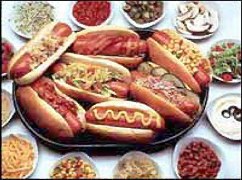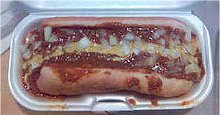 |
The Food Page!!!

 |
Hot dog...it's Hot Dogs!
|
|
Hot Dog links:
|
July is National Hot Dog Month, and according to the National Hot Dog and Sausage Council, Americans will be consuming the infamous little red tubes of "meat" in record numbers this summer.
The Council estimates that over seven billion hot dogs will be eaten by Americans between Memorial Day and Labor Day. During the July 4th weekend alone (the biggest hot-dog holiday of the year), 155 million will be downed.
Every year, Americans eat an average of 60 hot dogs each. They are clearly one of the country's most loved, but most misunderstood, comfort foods. Below you'll find some frequently asked questions regarding the hot dog. For more information, visit the Council's website at www.hot-dog.org. Bon appétit.
How did the hot dog get its name?
The term "hot dog" is credited to sports cartoonist Tad Dorgan. At a 1901 baseball game at the Polo Grounds in New York, vendors began selling hot dachsund sausages in rolls.
From the press box, Dorgan could hear the vendors yelling, "Get your dachshund sausages while they're red hot!" He sketched a cartoon depicting the scene but wasn't sure how to spell "dachshund" so he called them simply, "hot dogs." And the rest is history.
What exactly is a hot dog made of?
Nope. You're not allowed to ask that one. And do you really want to know anyway? For the record, the Council refers to the actual meat as "specially selected meat trimmings." They would like to point out, however, that thanks to stricter U.S. Department of Agriculture rules, hot-dog meat has become much leaner and, unless otherwise indicated, must be made from muscle (as most meat found in supermarkets is).
Most supermarket hot dogs use cellulose casings, which are removed before packaging. Some, however, still use the traditional natural casings, made from animal intestines.
By law, a hot dog can contain up to 3.5 percent of "non-meat ingredients." Don't be scared. This is usually just some type of milk or soy product used to add to the nutritional value. Many hot dogs may be relatively high in fat and sodium, but they are also a good source of protein, iron, and other necessary vitamins.
What is the most popular condiment for a hot dog?
Council research shows that for adults, mustard is the condiment of choice, while children prefer ketchup. That said, preferences do change from region to region. For instance, hot dogs in New York are generally served with a lighter mustard and steamed onions, while Chicago hot dogs can come with mustard, relish, onions, tomato slices, or pretty much anything at all.
Kids were also asked what condiment they would use "if their moms weren't watching," and 25 percent opted for chocolate sauce.
Do I spread my condiment on the meat or on the bread?
Always dress the dog and not the bun. The Council also recommends the following order for condiment application: first wet (mustard for example), then chunky (relish or onions), then cheese if desired, then any spices.
What should I drink with my hot dog?
Lemonade and iced tea—the tastiest drinks for a summer barbecue—are perfect with hot dogs.
|

|

 |
Hot dog...the history
|
|
Hot dog is the term for either a type of sausage or, alternatively, a sandwich with that same sort of sausage held in a bun. Hot dogs are traditionally made from beef, pork, or a combination of those meats, regionally spiced to resemble flavors ranging from spicy salami to bland bologna. They are softer, more moist, more even in texture and mixture of ingredients than most sausages, and the sausage most readily eaten as finger food, especially in the U.S.. Vegetarian sausages made from Meat analogue can also be made into hot dogs. Vegetarian Condiments can be added.
Hot dogs are also called frankfurters, or franks for short (named after the city of Frankfurt, Germany), wieners or weenies (named after the city of Vienna, Austria), or sarcastically as tube steaks (illustrating that hot dogs are typically among the least expensive meat products one can obtain).
|
Large Hotdog with tomato ketchup
|

A "home-cooked" hot dog with mayo, onion, and pickle relish
|
The American story of the invention of the hot dog, like the hamburger and ice cream cone, is often attributed to the 1904 Louisiana Purchase Exposition in St. Louis, Missouri. However, similar sausages were made and consumed in Europe, particularly in Germany, as early as 1864, and the earliest example of a hot dog bun dates to New York City in the 1860s. The hot dog's association with baseball also predates the 1904 Exposition. St. Louis Browns owner Chris von der Ahe sold them at his ballpark in the 1880s.
Hot dogs were frequently known as frankfurters or franks, but the name "hot dog" became popular by the early 1900s. The origin of this name is not precisely known, but at that time hot dogs were often marketed as "dachshund sausages" since they resemble the dog breed of that name. Hot dog lore suggests that newspaper cartoonist Tad Dorgan coined (or at least popularized) the term "hot dog" when he used it it in the caption of a 1906 cartoon illustrating sausage vendors at the Polo Grounds baseball stadium because he couldn't spell "dachshund." However, this rumored cartoon has never been located. While "hot dog" remains by far the most commonly heard term in spoken language, people buying them in grocery stores need to know that they are still almost always labelled as "franks", which is rarely heard in actual speech.
In 2001 the National Hot Dog and Sausage Council stated that others assert the hot dog was created in the late 1600s by Johann Georghehner, a butcher living in the German city of Coburg. Others have also been "acknowledged" for supposedly inventing the hot dog. Charles Feltman and Antonoine Feuchtwanger are among this group.
|

A hot dog is typically distinguishable from bratwurst, kielbasa and other sausages by its smaller size and relative lack of spicing. A regular hot dog is roughly 6 inches in length (15 cm), and thickness and length can vary. Twelve inch (30 cm) or "footlong" hot dogs are popular in some regions. The absence of spices and its smaller size translates into the product being more commonly eaten by children than other sausages.
There is no fixed specification for hot dog meat, with pork and beef being the most popular. Less expensive hot dogs typically contain chicken, due to the low cost and availability of mechanically separated chicken, and some pork. Hot dogs are generally regarded as unhealthy insofar as most have high sodium and fat content. Contents can also be questionable, with cheaper types of hot dogs having been known to contain snouts, ears and organ meat blended.
In recent years, manufacturers have turned to completely turkey, chicken, or vegetarian meat substitutes as well as lowering the salt content; due to changing dietary preferences in the U.S.
In general, if a manufacturer produces two different hot-dog-type sausages, "wieners" tend to contain pork, and to be the blander of the two, while "franks" tend to be all-beef, and more strongly seasoned. This is particularly true of Oscar Mayer.
A kosher hot dog is one made in accordance with Jewish dietary laws, which include a ban on pork. Kosher hot dogs are popular at some American baseball stadiums. Kosher hot dogs are similar to the kinds, kosher and non-kosher, popular in New York City, and are preferred by some consumers for their distinctive taste, texture and spicing. These premium brands are often all-beef.
|
|

One of the more recent developments in hot dog preparation: The hot dog toaster.
|
Hot dogs may be grilled, steamed, boiled, pan fried, deep fried, broiled, microwaved, or eaten cold (the sausages themselves are cooked before packaging).
A hot dog on a stick fried in corn batter is commonly called a corn dog ('battered sav' or 'dagwood dog' or 'pluto pup' in Australia). A corn dog might be eaten plain or with mustard or ketchup. Corn dogs are popular in the U.S. and are widely associated with state fairs and other public gatherings. A hot dog which is split down the center, stuffed with cheese, wrapped in bacon and deep-fried is known as a francheesie.
Other variations are found. A hot dog served with the addition of cheese is known as a "cheese hotdog" or simply a "cheese dog". "Cheese dog" may also refer to a hot dog that contains processed cheese within the hot dog itself. A hot dog served with the addition of chili is typically known as a "chili dog" or "coney dog" in New York. In Quebec, Canada this is known as a "michigan" due to its popularity and possible origin in that U.S. state. A hot dog served with both of these would be a "chili cheese dog" or "cheese coney". Chili dogs and cheese dogs are popular foods at carnivals and amusement parks.
|

Throughout the world, there are numerous variations in hot dog condiments from region to region. The most common are mustard, ketchup, chili, sauerkraut, coleslaw, pickle relish and chopped onion. Others include mayonnaise, chopped lettuce, tomato (chopped, sliced, or in wedges), pickle spear, celery salt, and chile pepper usually in a bun. See Table below for notable local variations on condiment content.
Though ketchup remains one of the most popular condiments on hot dogs in the USA, many Americans believe that a "properly made" hot dog, like the Chicago-style hot dog, should lack the condiment (See related article Ketchup on hot dogs). Those who consider themselves hot dog connoisseurs are often vehemently opposed to eating (or even witnessing) hot dogs with ketchup; they think the flavor of ketchup overpowers and destroys the taste of the hot dog instead of complementing it. The residents and hot-dog-sellers of Chicago are known to be especially vehement about this point.
|
Photograph of a Coney Island hot dog.
|

Hotdogs, cooked on a gas grill.
|
Hot dogs are the most widely consumed form of sausage in the USA. Scandinavia, especially Denmark, is famous for its hot dogs, as is Chicago and American baseball parks, especially Dodger Stadium. In Toronto, Canada, hotdogs are the only kind of street food allowed by law. The law sets extremely high (almost unachievable) requirements for street-food vendors, with an exception for hot dogs, resulting in greater competition between vendors. Takeru Kobayashi is the world's fastest hot dog eater. In 2002 he beat his previous record by one half of a hot dog, consuming 50.5 Nathan's famous hot dogs in 12 minutes. On July 4, 2004 he set a new record when he ate 53.5 in the same amount of time. The world's longest hot dog created was 20 m (65.6 feet] long. Mickey Mouse's first spoken words were "Hot Dogs!". In Cuba they are known as perros calientes - a literal translation into Spanish. The city of Huntington, West Virginia hosts the annual West Virginia Hot Dog Festival.
|

In the USA, along with ballparks, regional restaurants offer hot dogs. Few national chains in the USA offer the sandwich though, especially considering its ease in preperation makes it ideal for fast food service. A few chains in the USA that offer hot dogs include Sonic Drive-In, who call it a coney, Hardee's (called Carl's Jr. on the west coast of the United States), Wienerschnitzel (originally Der Wienerschnitzel), whose menus focuses on hot dogs, Woody's Chicago Style and A&W. Krystal resturants in the southeast offer a small hot dog called a Krystal Pup.
|
A deep fried "Jersey Breakfast" dog, wrapped with bacon and served over a fried egg and melted cheese, from Amazing Hot
|
|

|
 |







